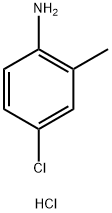Chemical Properties
The chloromethylanilines are colorless or
white crystalline solids or liquids, some have a mild
fishy odor.
Uses
p-Chloro-o-toluidine and its hydrochloride salt are used in manufacturing azo dyes for cotton, silk, acetate, and nylon and as intermediates in the production of the dyes C.I. 12800, pigment red 7, and pigment yellow 49 (IARC 1990, 2000). p-Chloro-o-toluidine has also been used since the 1960s in the manufacture of the pesticide (insecticide and acaricide) chlordimeform. It is believed that chlordimeformis no longer produced or used worldwide (IARC 1990).
General Description
A white crystalline solid. Toxic by skin absorption and inhalation (dust).
Air & Water Reactions
4-CHLORO-O-TOLUIDINE HYDROCHLORIDE may be sensitive to prolonged exposure to air and light. Water soluble.
Reactivity Profile
Incompatible with acids, acid chlorides, acid anhydrides, chloroformates and strong oxidizing agents. .
Hazard
Toxic by ingestion, inhalation, and skin
absorption.
Health Hazard
TOXIC; inhalation, ingestion or skin contact with material may cause severe injury or death. Contact with molten substance may cause severe burns to skin and eyes. Avoid any skin contact. Effects of contact or inhalation may be delayed. Fire may produce irritating, corrosive and/or toxic gases. Runoff from fire control or dilution water may be corrosive and/or toxic and cause pollution.
Fire Hazard
Combustible material: may burn but does not ignite readily. When heated, vapors may form explosive mixtures with air: indoors, outdoors and sewers explosion hazards. Contact with metals may evolve flammable hydrogen gas. Containers may explode when heated. Runoff may pollute waterways. Substance may be transported in a molten form.
Safety Profile
Confirmed carcinogen
with experimental carcinogenic data.
Moderately toxic by intraperitoneal route.
When heated to decomposition it emits
toxic fumes of NOx and Cl-. See also other
chloro toluidine entries.
Potential Exposure
Most of the isomers are used in dyestuff manufacture. The 3-chloro-para isomer is used to kill
birds. It is marketed as pelleted bait for control of bird
populations.
Carcinogenicity
p-Chloro-o-toluidine and its hydrochloride salt are reasonably anticipated to be human carcinogens based on limited evidence of carcinogenicity from studies in humans and evidence of carcinogenicity from studies in experimental animals.
Shipping
UN2239 Chlorotoluidines, solid, Hazard Class:
6.1; Labels: 6.1-Poisonous materials. UN3429
Chlorotoluidines, liquid, Hazard Class: 6.1; Labels: 6.1-
Poisonous materials
Incompatibilities
Incompatible with oxidizers, strong
acids; chloroformates, and acid anhydrides, isocyanates,
aldehydes forming fire and explosive hazards.



